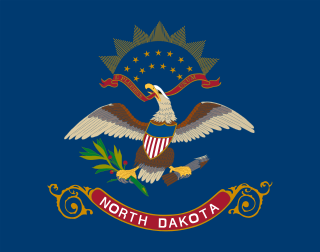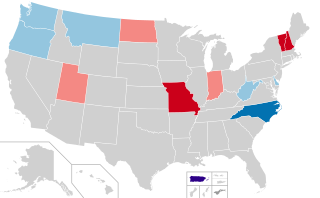
Presidential elections were held in the United States on November 5, 1912. Democratic governor Woodrow Wilson of New Jersey unseated incumbent Republican president William Howard Taft while defeating former president Theodore Roosevelt and Socialist Party nominee Eugene V. Debs.

Presidential elections were held in the United States on November 7, 1916. Incumbent Democratic President Woodrow Wilson narrowly defeated former associate justice of the Supreme Court Charles Evans Hughes, the Republican candidate.

Presidential elections were held in the United States on November 4, 1924. Incumbent Republican President Calvin Coolidge won election to a full term. Coolidge was the second vice president, after Theodore Roosevelt, to ascend to the presidency and then win a full term.

Presidential elections were held in the United States on November 3, 1936. In the midst of the Great Depression, incumbent Democratic President Franklin D. Roosevelt defeated Republican governor Alf Landon of Kansas in a landslide victory. Roosevelt won the highest share of the popular vote (60.8%) and the electoral vote since the largely uncontested 1820 election. The sweeping victory consolidated the New Deal Coalition in control of the Fifth Party System.
The North Dakota Democratic–Nonpartisan League Party is the North Dakota affiliate of the national Democratic Party. It was formed as the outcome of a merger of two parties; the state previously had a three-party political system. It is one of only two state Democratic Party affiliates to have a different name from the central party, the other is the neighboring Minnesota Democratic–Farmer–Labor Party.

John Burke was an American lawyer, jurist, and political leader from North Dakota who served as the tenth governor of North Dakota from 1907 to 1913, and later served as the 24th treasurer of the United States under President Woodrow Wilson from 1913 to 1921. Following his term as treasurer, he subsequently served intermittently as Chief Justice of the North Dakota Supreme Court first from 1929 to 1931, then from 1935 until his death in 1937.

The 1980 United States Senate elections were held on November 4, coinciding with Ronald Reagan's victory in the presidential election. The 34 Senate seats of Class 3 were contested in regular elections. Reagan's large margin of victory over incumbent Jimmy Carter gave a huge boost to Republican Senate candidates, allowing them to flip 12 Democratic seats and win control of the chamber for the first time since the end of the 83rd Congress in January 1955. This was the first time since 1966 that any party successfully defended all their own seats.

Michael Kieran Reilly was an Irish American lawyer and Democratic politician from Fond du Lac, Wisconsin. He served six full terms and one partial term in the U.S. House of Representatives, representing Wisconsin's 6th congressional district from 1913 to 1917, and from December 1930 to January 1939. Earlier in his career, he served as district attorney of Fond du Lac County and city attorney of Fond du Lac.
Alexander John McKenzie (1850–1922) was a lawman and politician in early North Dakota. As the Republican national committeeman from North Dakota, he directed a highly successful political machine, and was known as the "senator-maker." He was highly influential in North Dakota and in neighboring Montana and Minnesota. He served time in prison for corruption, and became the first North Dakotan to receive a presidential pardon.

The politics of North Dakota were shaped historically by early settlement by people from the Northern Tier, who carried their politics west ultimately from New England, upstate New York, and the Upper Midwest. The area and state also received numerous European immigrants and migrants, particularly during the era of opening up of former Native American lands for sale and settlement.

The 2010 United States Senate election in North Dakota took place on November 2, 2010, alongside other elections to the United States Senate in other states as well as elections to the United States House of Representatives and various state and local elections. Incumbent Democratic Senator Byron Dorgan announced in January 2010 that he would not seek reelection, leading to the first open seat election since 1992. Governor John Hoeven won the seat in a landslide, taking 76.1% of the vote, sweeping every county in the state, and becoming North Dakota's first Republican senator since 1987. Hoeven's 54 point margin of victory was a dramatic and historic shift from the previous election for this seat, when Dorgan won reelection in a 36-point landslide and himself swept every county in the state.

The 1912 Minnesota gubernatorial election took place on November 5, 1912. Republican Party of Minnesota candidate Adolph Olson Eberhart defeated Democratic Party of Minnesota challenger Peter M. Ringdal.

The 2010 House election in North Dakota took place on November 2, 2010, to elect the state's at-large Representative to the United States House of Representatives. Representatives are elected for two-year terms; this election was for the 112th Congress from January 3, 2011, until January 3, 2013. North Dakota has one seat in the House, apportioned according to the 2000 United States census.

United States gubernatorial elections were held on November 8, 2016, in 12 states and two territories. The last regular gubernatorial elections for nine of the 12 states took place in 2012. The last gubernatorial elections for New Hampshire, Oregon, and Vermont took place in 2014, as Oregon held a special election due to the resignation of Governor John Kitzhaber, while the governors of New Hampshire and Vermont both serve two-year terms. The 2016 gubernatorial elections took place concurrently with several other federal, state, and local elections, including the presidential election, Senate, and House elections.

The 2018 United States House of Representatives elections in Texas were held on Tuesday, November 6, 2018. Voters elected the 36 U.S. representatives from the state of Texas, one from each of the state's 36 congressional districts. The elections coincided with the elections of other offices, including the gubernatorial election, as well as other elections to the House of Representatives, elections to the United States Senate and various state and local elections. The primaries were held on March 6 and the run-offs were held on May 22.

The 1924 United States presidential election in North Dakota took place on November 4, 1924, as part of the 1924 United States presidential election which was held throughout all contemporary 48 states. Voters chose five representatives, or electors to the Electoral College, who voted for president and vice president.

The 1936 United States presidential election in North Dakota took place on November 3, 1936, as part of the 1936 United States presidential election. Voters chose four representatives, or electors to the Electoral College, who voted for president and vice president.

In the Chicago mayoral election of 1907, Republican Fred A. Busse defeated Democratic incumbent Edward F. Dunne.

The 2022 United States House of Representatives elections in Michigan were held on November 8, 2022, to elect representatives for the thirteen seats in Michigan. The deadline for candidates to file for the August 2 primary was April 19. The congressional makeup prior to the election was seven Democrats and seven Republicans. However, after the 2020 census, Michigan lost one congressional seat. Democrats won a majority of seats in the state for the first time since 2008. This can be partly attributed to the decrease in the number of districts, which resulted in two Republican incumbents – Bill Huizenga and Fred Upton – in the new 4th district. Redistricting also played a part in shifting partisan lean of the districts which favored the Democrats overall, including in the 3rd district, which Democrats were able to flip with a margin of victory of 13 points. That was made possible by a non-partisan citizens' commission drawing the new political boundaries instead of the Michigan legislature after a 2018 ballot proposal was approved.

The 1904 North Dakota gubernatorial election was held on November 8, 1904. Republican nominee Elmore Y. Sarles defeated Democratic nominee Marthinus F. Hegge with 70.71% of the vote.




















